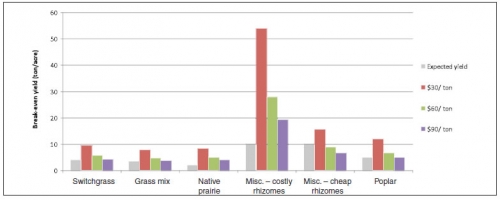Breakeven Yield
The comparative break-even yield identifies the biomass yield needed from a biofuel crop for it to be as profitable as continuous corn. Most biomass crops are still relatively unimproved by genetic engineering or traditional breeding methods, so there is potential for significant yield improvements in the near term. In addition, best production practices have yet to be precisely determined. It is reasonable to expect that yields for all biomass crops will increase as research into these crops continues, though obviously it is not certain to what extent. The important question for farmers is at what point the expected yield of a biomass crop would make it equally profitable to a corn system. The comparative break-even yield formula is similar to that used for comparative break-even price . Break-even yields for selected biomass crops are presented in Figure 2. The first column for each crop shows the current expected yield. Note that, for this analysis, the corn price is held at $3.50 per bushel. At $60/ton for biomass, the break-even yield for miscanthus with cheap rhizomes is 8.8 tons/acre, well below the 10 tons/acre that the crop could likely achieve in Michigan. The break-even yields for switchgrass, grass mix and poplar at that price -- 5.6 tons, 4.8 tons and 6.8 tons, respectively -- are possible to achieve with existing cultivars in Michigan, though only on the best soils.
Figure 2. Comparative break-even yields at $3.50 corn grain and three biomass prices ($/ton).

To calculate comparative break-even yield:





 Print
Print Email
Email